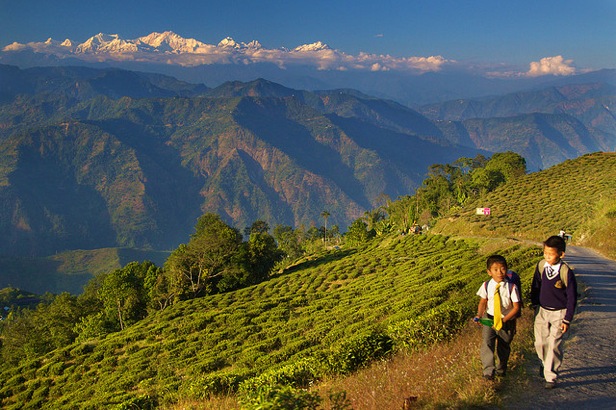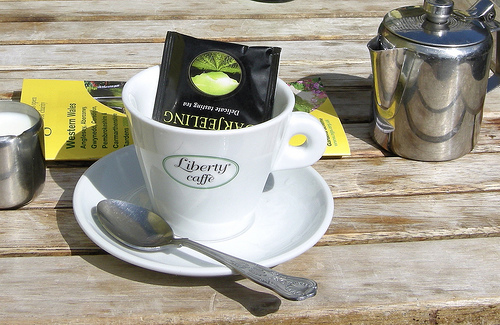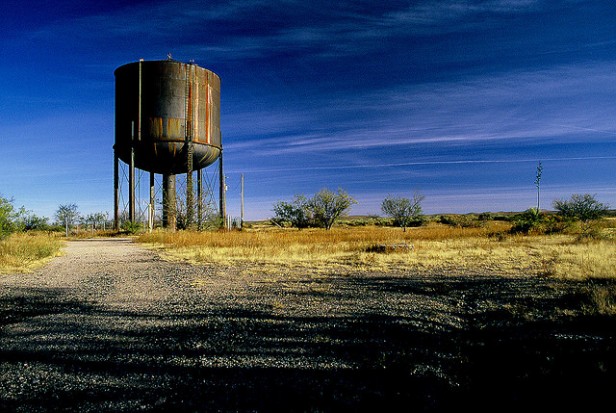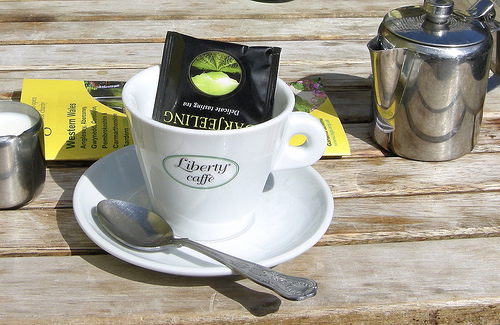 Two school kids walking home in the mountainous town of Darjeeling, West Bengal, India. Tea bushes cling to the hillsides Photo: Daniel Peckham
Two school kids walking home in the mountainous town of Darjeeling, West Bengal, India. Tea bushes cling to the hillsides Photo: Daniel Peckham
Over on the WorldWatch Institute blog, Dan Kane’s got an interesting post on working conditions in Darjeeling, India, one of the globe’s most celebrated tea-growing regions.
According to classical economic dogma, demand for hot-weather-requiring products like fancy tea in wealthy, northern areas like the United States should benefit everyone. U.S. consumers get a rarefied product they’d otherwise not have access to; warm regions get infusions of hard currency, which finance development and reduce poverty.
As Kane shows in his post, the second part of the deal too often goes sour. Proceeds from products like prestige tea are at least as likely to finance ecological devastation as they are, say, schools:
Plantations also clear hillsides of trees to maximize the acreage of tea bushes, causing erosion and a more rapid degradation of the rich soil that gives the tea its unique flavor. Deforestation for tea is destroying the habitat of iconic Indian species, like the jaguar, and compromising important ecosystem services.
Moreover, large monocrops require heavy doses of chemical poisons. Kane points to the recent documentary The Bitter Taste of Tea, which shows tea-plantation workers routinely not getting ample access to protective gear while applying pesticides.
 Care for a cuppa?Photo: Peter Ashley JacksonAnd then there’s the wage issue. On the premise that a rising tide floats all boats, Darjeeling’s prestige in the tea market should be building wealth for the area’s residents. Not so much, Kane writes. Despite the high price fetched by Darjeeling in the U.S. — a box of Twinings Darjeeling tea bags fetches $5 for 100 grams, or about $25/pound — workers on the ground get paid very little, than $1.50 per day for their long hours among the tea bushes. And lest you speculate that $1.50 per day amounts to a decent wage in India, Kane adds this:
Care for a cuppa?Photo: Peter Ashley JacksonAnd then there’s the wage issue. On the premise that a rising tide floats all boats, Darjeeling’s prestige in the tea market should be building wealth for the area’s residents. Not so much, Kane writes. Despite the high price fetched by Darjeeling in the U.S. — a box of Twinings Darjeeling tea bags fetches $5 for 100 grams, or about $25/pound — workers on the ground get paid very little, than $1.50 per day for their long hours among the tea bushes. And lest you speculate that $1.50 per day amounts to a decent wage in India, Kane adds this:
The majority of tea laborers are women, who pick all the leaves by hand, leaving them little opportunity to pursue other work. Families often remain on a plantation for generations, unable to earn enough money to leave; and children often start work at a young age, forgoing school to help the family make ends meet.
So rather than pull workers out of poverty, Darjeeling’s tea industry generates a kind of permanent indentured-servant class.
Oh no, we meant “Fare” Trade
Unhappily, simply buying tea labeled Fair Trade doesn’t much affect conditions on the ground in Darjeeling, either. According to Kane, “Even those plantations labeled as Fair Trade by the Fair Trade Labeling Organization (FLO) and receive a premium price for their product rarely pass on these profits to laborers.”
To me, this is devastating. Even Western consumers who try to do the right thing by buying Fair Trade are financing ecological damage and poverty cycles in Darjeeling.
But even as Kane shows that the conventional trade model as well as its Fair Trade variant is failing on many important fronts in Darjeeling, he also points to an alternative: a cooperative project started by families who took over a tea plantation abandoned when the British left India in 1947. For decades, Kane writes, they shunned the global tea market and supported themselves through subsistence agriculture. Then 10 years ago, with the help of NGOs, they formed a dairy cooperative called Sanjukta Vikas Cooperative (SVC) to sell milk locally. Later, they revived the old tea bushes and began to produce organic tea, marketed in the United States by Massachusetts-based Equal Exchange under a Fair Trade label.
Unlike other Fair Trade situations, this one distributes the rewards of the higher retail price widely, Kame reports. Profits have already been invested in schools and women’s health clinics. Most crucially of all, the cooperative is hinged on polyculture and economic diversity, not monoculture and specialization.
Kane writes:
With increased profits, SVC has also been able to expand beyond tea and dairy. With the help of DLR Prerna, many SVC farmers have developed permaculture operations, integrating their tea bushes into agroforestry systems in which they grow cardamom, fresh vegetables, and raise cows and chickens. Trees prevent soil erosion and maintain habitat for animals that reduce pest pressure, and cows and chickens provide manure that can be used to fertilize crops. By diversifying their production, farmers are also creating more markets for their goods, giving them added financial security.
These farmers have turned their involvement in the global tea trade into hard assets: schools, clinics, and food-production infrastructure. If the price of tea plunges — all commodity markets are subject to volatility based on the whims of distant traders as well as random weather events — they’ll still be able to produce food for themselves and their neighbors to eat. (Plantation owners who devote all their land to monocropped tea, by contrast, would be ruined by a prolonged slump in tea prices — and their workers would be devastated.) And in addition to building economic resiliency, the SVC farmers are also building ecological resiliency, by not resorting to monocrops and agrichemicals.
To me, Sanjukta Vikas Cooperative represents a model of global food trade that makes sense. Note that it relies on Western consumers who view imported beverages like tea as a luxury commodity that needs to be savored, not something to mindlessly slurp down by the bucketful. (News that Starbucks has begun selling a nearly quart-sized cup of coffee reveals just how far we have to go on that score.)
It also relies on economic models that gives grower-workers a fair share of market power, and don’t concentrate market power between plantation owners and large buyers. As Kane shows, the Fair Trade label alone doesn’t guarantee that such arrangements are in place.
Tea party blues
I think the lesson here is that global trade in food and agricultural products works best when it’s done in a limited fashion. The Sanjukta Vikas Cooperative people aren’t trying to maximize their production of tea; they’re using tea as an important part of a diversified system that also produces food for local consumption. Nor is their U.S. partner, Equal Exchange, pushing them to ramp up production; instead, they’re using the Sanjukta Vikas story as a marketing tool to get a premium price for the tea, making up in price what they’re losing in volume. In this scenario, trade bolsters — rather than undermines — local food production.
But if food trade that makes sense involves limits, U.S. food/ag trade policy — and that
of allied institutions like the International Monetary Fund and the World Bank — at least since the Reagan years has been about the removal of limits: maximum production and zero barriers. To examine the fruits of this policy, one need only look at the evisceration of Mexico’s smallholder farmers since NAFTA, or the World Bank-induced coffee crisis of the late ’90s/early ’00s, or what happened to Haitian agriculture under Bill Clinton’s influence.
I would like to report that President Obama has rethought the trade-as-panacea policy. But the president has been a vigorous promoter of ag trade, declaring his intention to double ag exports over the next five years and tapping a pesticide-industry lobbyist to set the ag-trade agenda.
Until policy changes, it’s likely that projects like Sanjukta Vikas will remain the tiny exception to a monstrous rule. But that just means that conscientious U.S. consumers with the means to do so should ramp up their efforts to identify such projects and pay up for their products.



